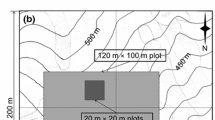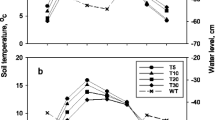Abstract
For understanding forest nutrient cycling, a reliable method to estimate belowground (root) production is needed. The methods employed so far are unsatisfactory (6) The aim this study was to utilize recent knowledge on soil microbial maintenance requirement (2) for estimating belowground production in forests. The amount of soil microbial biomass C (Cmic) is usually limited by the microbially available C. Hence, if Cmic and the maintenance coefficient (m) (mg glucose-C mg-1Cmic h-1) are known, it should be possible to calculate the amount of available substrate C.
Access this chapter
Tax calculation will be finalised at checkout
Purchases are for personal use only
Similar content being viewed by others
References
Anderson, J.P.E. and Domsch, K.H. (1978) A physiological method for the quantitative measurement of microbial biomass in soils. Soil Biol. Biochem. 10: 215–221.
Anderson, T.-H. and Domsch, K.H. (1986) Carbon assimilation and microbial activity in soil. Z. Pflanzenern. Bodenk. 149: 457–468.
Heinemeyer, O., Insam, H., Kaiser, E.A. and Walenzik, G. (1989) Soil microbial biomass and respiration measurements: An automated technique based on infrared gas analysis. Plant Soil 116: 191–195.
Insam, H., Ding, M.-M. and Mariotti, A. (1991) Utilization of a 13C enriched tracer for carbon flux studies in a tropical Eucalyptus exserta forest. Proc. Int. Symp. Use Stable Isotopes, IAEA, Vienna.
Krieger, H., Schäfer, H., Peng, S.-L., Li, Z.-A. and Chang, W.-Q. (1990) Growth dynamics of a planted Eucalyptus exserta (F. Muell.) stand in South China — adaptation of a generic simulation model. Arbeitsberichte GHK, Kassel
Kurz, W.A. and Kimmins, J.P. (1987) Analysis of some sources of error in methods used to determine fine root production in forest soils: a simulation approach. Can. J. For. Res. 17: 909–912
Author information
Authors and Affiliations
Editor information
Editors and Affiliations
Rights and permissions
Copyright information
© 1992 ECSC, EEC, EAEC, Brussels and Luxembourg
About this chapter
Cite this chapter
Insam, H., Mao, D.M., Min, Y.W., Yu, L.L., Cheng, Y.J. (1992). A New Method to Determine Belowground Production in Forest Ecosystems. In: Teller, A., Mathy, P., Jeffers, J.N.R. (eds) Responses of Forest Ecosystems to Environmental Changes. Springer, Dordrecht. https://doi.org/10.1007/978-94-011-2866-7_154
Download citation
DOI: https://doi.org/10.1007/978-94-011-2866-7_154
Publisher Name: Springer, Dordrecht
Print ISBN: 978-1-85166-878-6
Online ISBN: 978-94-011-2866-7
eBook Packages: Springer Book Archive




